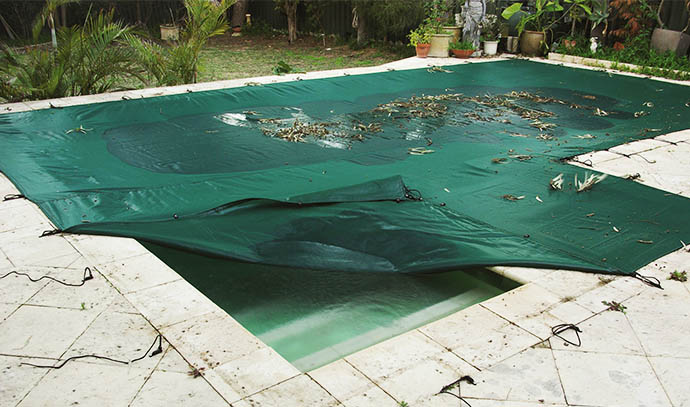swimart-technician-checks-pool-water
How to fix a green pool
Jane Ryder, March
2018
Pool owners are urged to keep a weather eye on their pool water this autumn – particularly with the combination of high temperatures and heavy rain in parts of the country. Regular pool water testing is vital, says pool and spa expert Swimart, which offers free computerised testing.
The recent heavy rainfalls in northern NSW and Queensland may have been welcomed by drought-stricken farmers, but it can create a perfect breeding ground for algae, bacteria and parasites.
“Extended periods of heavy rain dilutes water treatment chemicals and, combined with the warmer-than-average temperatures, encourages the growth of water-borne bacteria and parasites that can make swimmers ill,” explains Swimart’s Australasian manager Chris Fitzmaurice.
With a costly clean-up facing many residents, Swimart Australasian manager Chris Fitzmaurice is reminding pool owners to check their water quality as soon as possible to avoid contamination with bacteria and parasites such as E. coli, Salmonella, noroviruses, Cryptosporidium and Campylobacter, which causes gastroenteritis.
“During periods of heavy rain, pool owners need to be extra diligent with monitoring their pool water to ensure it’s clean, clear and healthy,” says Chris, who recommends testing pool water every couple of days and to immediately add water treatment chemicals and salt if levels are low.
“In addition to working as a pool water sanitiser, chlorine is an effective and quick fix for algae and bacteria growth in pools,” he says.
After the algae is killed, a phosphate starver can be added to pool water to deter algae from taking hold again.
[caption id="" align="alignnone" width="690"] Heavy rain dilutes pool chemicals, especially salt and chlorine, which makes the pool turn green. Images courtesy Swimart.[/caption]
Heavy rain dilutes pool chemicals, especially salt and chlorine, which makes the pool turn green. Images courtesy Swimart.[/caption]
 Covering your pool when it’s not in use keeps the water clean by preventing leaves and debris from blowing in. Here are a few more reasons why you need to invest in a pool cover.[/caption]
Covering your pool when it’s not in use keeps the water clean by preventing leaves and debris from blowing in. Here are a few more reasons why you need to invest in a pool cover.[/caption]
 Heavy rain dilutes pool chemicals, especially salt and chlorine, which makes the pool turn green. Images courtesy Swimart.[/caption]
Heavy rain dilutes pool chemicals, especially salt and chlorine, which makes the pool turn green. Images courtesy Swimart.[/caption]
Turn your pool from green to clean with Swimart's 5 top tips
- Check your chlorine levels. If below 0.5ppm you need to 'shock' the pool water with a large dose of chlorine to 10ppm. Ensure the filters are running and don't use the pool until the chlorine level falls below 3ppm
- Lower the pH levels by adding acid. Then later add a copper treatment to the water to kill the spores. Aim for a pH level of between 7 and 7.6. Heavy rain, lots of swimmers and animals such as dogs can increase pH levels
- Use a quality algaecide to kill algae
- Brush pool walls to remove algae. Then vacuum the loosened algae from the pool floor the next day
- Make sure your filter is working effectively. Pool water needs to be filtered and will not clear up very quickly if you have a filter that doesn't work properly. It doesn't matter how much shock you put in the pool if you have a poor filter. Your Swimart technician can check your filter and other equipment and advise what the next steps should be
 Covering your pool when it’s not in use keeps the water clean by preventing leaves and debris from blowing in. Here are a few more reasons why you need to invest in a pool cover.[/caption]
Covering your pool when it’s not in use keeps the water clean by preventing leaves and debris from blowing in. Here are a few more reasons why you need to invest in a pool cover.[/caption]
Autumn pool care checklist
With a warmer-than-average autumn forecast* for much of Australia, you’ll not only be swimming for longer but have plenty of time to prepare your pool for the coming winter or, as Swimart calls it, ‘winterising’ your pool. While your autumn pool care plan will depend on a few factors such as the size of your pool and geographic location, the following 10 simple tips will help reduce energy bills, maintain healthy water and protect pool equipment over the coming months:- Regularly scoop the pool water and clear the skimmer basket of leaves and debris. Remove stains by reducing the chlorine level and using Aqua-health 3-in-1 Stain Remover
- Check your filter and as temperatures drop later in autumn, change the running mode from summer to winter
- Vacuum and brush pool walls and floor as needed to remove debris and reduce the likelihood of staining
- Regularly check sanitiser levels, ideally on a weekly basis
- Gradually reduce the number of hours you run your filter over the next two months
- Check the Total Alkalinity fortnightly
- Check the pH fortnightly and maintain between 7.2 and 7.8. Aqua-Health pH increaser or pH decreaser adjusts pH as required.
- With warmer temperatures, use an algaecide appropriate for your pool
- During winter, use a shock treatment to maintain clear, clean and healthy water. Once appropriate amount has been added, run both the pump and filter for several hours to ensure good distribution.
- Use a pool cover when the pool is not in use to prevent water loss via evaporation and debris entering and contaminating the water. Remember to remove it regularly to visually check the clarity of the pool water.



